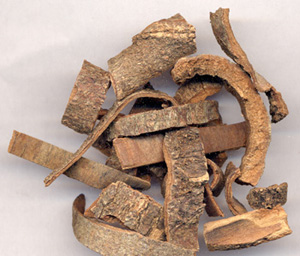肉桂
| Name (CN) | 肉桂 (Ròu guì) |
|---|---|
| Synonyms (CN) | 官桂:菌桂、筒桂、桂尔通、桂通、桂儿通、条桂。企边桂:清化桂。板桂:桂楠。其它称呼:桂、玉桂、肉桂、薄桂、安桂、牡桂、广肉桂、紫油桂、桂心、肉桂末、桂皮、油桂、牡桂、刁安、安边桂、大板桂、上油桂、蒙自桂、绿水桂、跤趾桂、黄瑶桂、丹阳木皮, 大桂, 辣桂, 紫桂, 官桂, 菌桂,筒桂, 条桂 |
| Name (EN) | Cinnamomi Cortex, Cinnamomum Cassia (Syn. Cinnamomum Aromaticum), Cassia Bark, Cinnamon Bark, Cassia Bark |
| Scientific name(s) | Cinnamomum Cassia Presl, Cinnamomi Cortex |
| Used section | Dried bark |
| Taste | Spicy、Sweet |
| Channel Tropism | Induce in the kidney, spleen, heart and liver meridians. |
| Cold/Hot properties | Hot |
| Group | Plant [Condiments] |

| Origin | It is the dried bark of Cinnamomum cassia Presl, family Camphoraceae. |
|---|---|
| Function and treatment | Tonifying fire to promote Yang, inducing fire to return to its source, dispersing cold and relieving pain, invigorating blood and promoting menstruation. Used for impotence, coldness in the uterus, cold pain in the waist and knees, kidney deficiency and asthma, Yang deficiency and vertigo, red eyes and sore throat, cold pain in the heart and abdomen, vomiting and diarrhea due to deficiency cold, cold hernia, dolphin, menorrhagia, dysmenorrhea. |
| Origin and best harvesting period | Cultivated in sandy soils and sloping hills. It is distributed in Fujian, Guangdong, Guangxi, and Yunnan. It is mainly produced in Guangxi, Guangdong and Yunnan. Cinnamon bark can be harvested 15 years after transplanting, and can be obtained by peeling off the bark and drying it in the sun. |